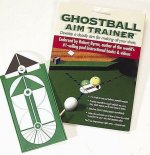In this photo I have shown three different reference points for aiming with three different methods. By giving your brain more solid reference points, when it comes to aiming, you can develop consistency much quicker.
In the pic the yellow circle represents where the ghostball should be in order to pocket the 6 ball. Of course there is no little yellow circle that you can see when playing. You must estimate it based on your experience with imagining ghostballs.
The blue circle on the 6 ball shows the approximate point of contact between the balls, which can be seen because it exists on a physical object -- the ball. This spot can can be seen by standing and looking straight though the 6 to the pocket, but it's really difficult to keep the exact spot in focus once you are back behind the cb, unless the contact point happens to be easily identified by the number or markings on the ball.
The white vertical lines on the 6 ball represent the ob quarters, which are simple to imagine/visualize because we are looking at the ball -- it's a physical object that we can see. Anyone with the slightest spacial skills can look at an object and visualize a line to the center of that object or to the outermost left or right visible point on the object. Granted, the outermost points are obvious, whereas the center and a quarter left or right of center require more spacial skills to pinpoint accurately. But still, you're working with a solid object, not something you can't see. Also, with ghostball and contact points, the aiming references vary with every shot. But ob references never vary -- the ball can always be divided into equal quarters, and then into eighths, sixteenths, etc... using the ball itself as an aiming reference on every shot.
This particular shot is a 3/8 aim, fractionally speaking. But you don't have to label it a "3/8". Just pay attention, regardless of which aiming method you use, to where you are aiming in reference to the ob itself. This gives your brain more visual information, which helps it build a more thorough database of recognized shots.
For those using ghostball or contact points, and seem to be struggling for consistency, start using the ob as a background reference in conjunction with the ghostball. Pay attention to where your shot line is pointed in reference to the ob itself. For contact point aimers it might be useful to know that the contact point is always halfway between the fractional aim line and the ccb to center ob line.

In the pic the yellow circle represents where the ghostball should be in order to pocket the 6 ball. Of course there is no little yellow circle that you can see when playing. You must estimate it based on your experience with imagining ghostballs.
The blue circle on the 6 ball shows the approximate point of contact between the balls, which can be seen because it exists on a physical object -- the ball. This spot can can be seen by standing and looking straight though the 6 to the pocket, but it's really difficult to keep the exact spot in focus once you are back behind the cb, unless the contact point happens to be easily identified by the number or markings on the ball.
The white vertical lines on the 6 ball represent the ob quarters, which are simple to imagine/visualize because we are looking at the ball -- it's a physical object that we can see. Anyone with the slightest spacial skills can look at an object and visualize a line to the center of that object or to the outermost left or right visible point on the object. Granted, the outermost points are obvious, whereas the center and a quarter left or right of center require more spacial skills to pinpoint accurately. But still, you're working with a solid object, not something you can't see. Also, with ghostball and contact points, the aiming references vary with every shot. But ob references never vary -- the ball can always be divided into equal quarters, and then into eighths, sixteenths, etc... using the ball itself as an aiming reference on every shot.
This particular shot is a 3/8 aim, fractionally speaking. But you don't have to label it a "3/8". Just pay attention, regardless of which aiming method you use, to where you are aiming in reference to the ob itself. This gives your brain more visual information, which helps it build a more thorough database of recognized shots.
For those using ghostball or contact points, and seem to be struggling for consistency, start using the ob as a background reference in conjunction with the ghostball. Pay attention to where your shot line is pointed in reference to the ob itself. For contact point aimers it might be useful to know that the contact point is always halfway between the fractional aim line and the ccb to center ob line.
Last edited:
